MARIANI’S
Virtual
Gourmet
March 14,
2021
NEWSLETTER

Joel McCrea in "The More the Merrier" (1943)
❖❖❖
IN THIS ISSUE
WITH COVID CASES NEXT TO ZERO,
PERHAPS IT'S TIME TO VISIT ICELAND
By John Mariani
NOTES FROM THE WINE CELLAR
STEVEN SPURRIER, INTERNATIONAL
WINE LEGEND, DIES AT 79
By John Mariani
NEW YORK CORNER
LOVE AND PIZZA
Chapter 51
By John Mariani
❖❖❖
WITH COVID CASES NEXT TO ZERO,
PERHAPS IT'S TIME TO VISIT ICELAND
By John Mariani
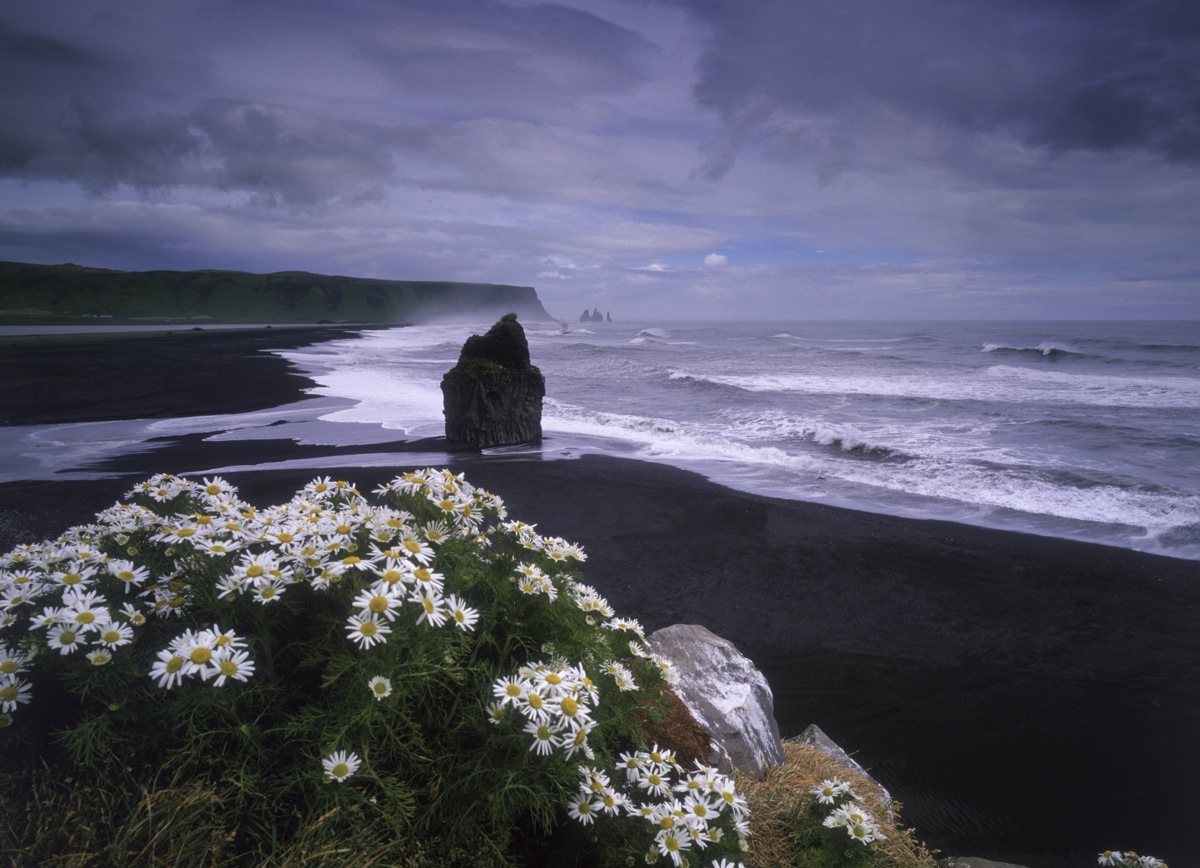
I
have often wondered what
my last words on earth would be. And a
few years ago, after my SUV started
sinking into a raging river on the far
side of the Icelandic volcano
Eyjafjallajökull (left) that
carved Iceland several new ones when
it blew,
it turned out to be something
unprintable.
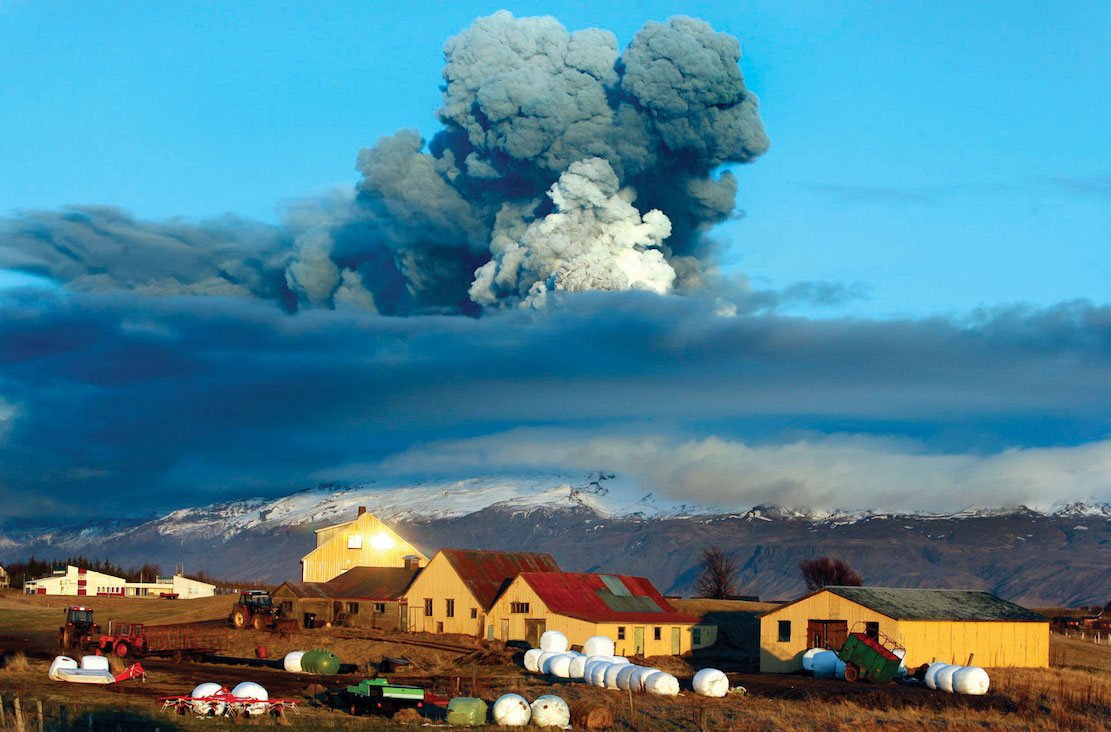 My
guide, whose name was Ingy, had
crisscrossed this territory a thousand
times, but this was a new river, flanked
by thousands of acres of muddy tundra
onto which the great god
Eyjafjallajökull had tossed rocks that
ranged from the size of basketballs to
haystacks.
Ingy managed to dodge them all,
then decided to ford this new river,
telling me not to worry because the
truck had 46-inch wheels.
My
guide, whose name was Ingy, had
crisscrossed this territory a thousand
times, but this was a new river, flanked
by thousands of acres of muddy tundra
onto which the great god
Eyjafjallajökull had tossed rocks that
ranged from the size of basketballs to
haystacks.
Ingy managed to dodge them all,
then decided to ford this new river,
telling me not to worry because the
truck had 46-inch wheels.
Down the edge of the river we
went, into the icy water, only to find
ourselves carried along, sinking fast,
in the flow. Then,
a few long seconds after I shouted my
last words, the tires caught hold of the
river bottom and dragged us to safety. Ingy
shook his head and said, “Well, I’ve
been through vorse.”
“Oh yeah? When?”
“Oh, maybe fifteen years ago.”
I screamed at him, “You mean this
is the second
worst river crossing you’ve ever been
through?” 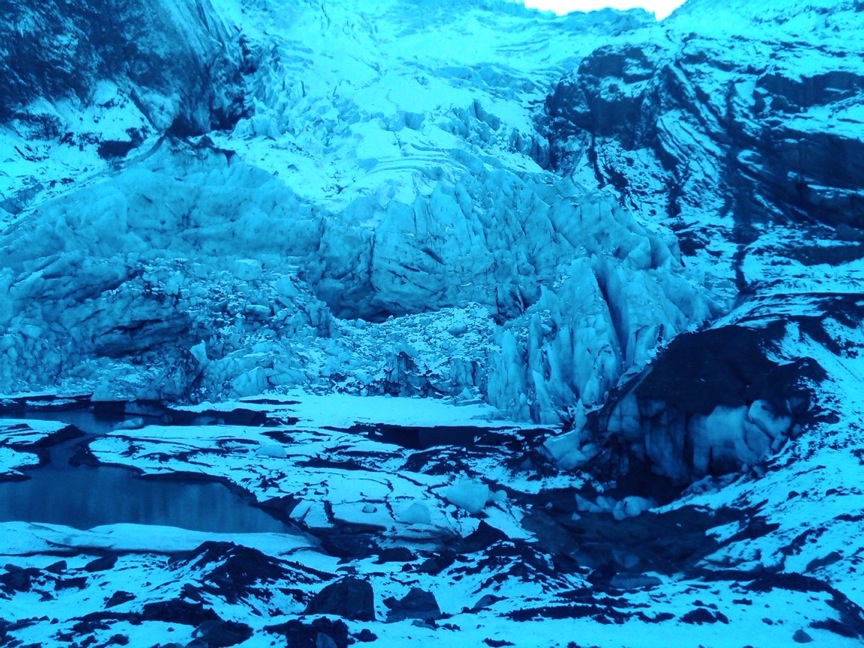
“Well, maybe this vas
just as bad. You just never can tell
with these new cracks in the earth.”
Ingy then set about testing the
depth of the water at different points
by throwing big rocks in the center of
the river. “If they make a big splash,
or if you can count to three before
hearing them hit bottom, it’s too deep
to cross. If black sand comes up, it
could be quick sand.” After
tossing about ten rocks into the river,
he gave up. “I think we take another
route.”
Back in Reykjavik, steadying my
nerves with a drink of the local
cumin-flavored liquor called Brenbin
(which means “black death”), I had time
to think about my near demise, but it
was nudged out of my mind by the
memories of seeing that day the
terrible, strange beauty that
Eyjafjallajökull had wrought after
blowing a new crater in its side,
causing new rivers gushing down
blue-green glacial ice, creating
electrical storms, and spewing so much
ash into the sky that air travel was
disrupted in Europe for nearly a week. That
fall, farmers around the volcano had
their best crops ever, owing to the rich
mineral ash that covered their land.
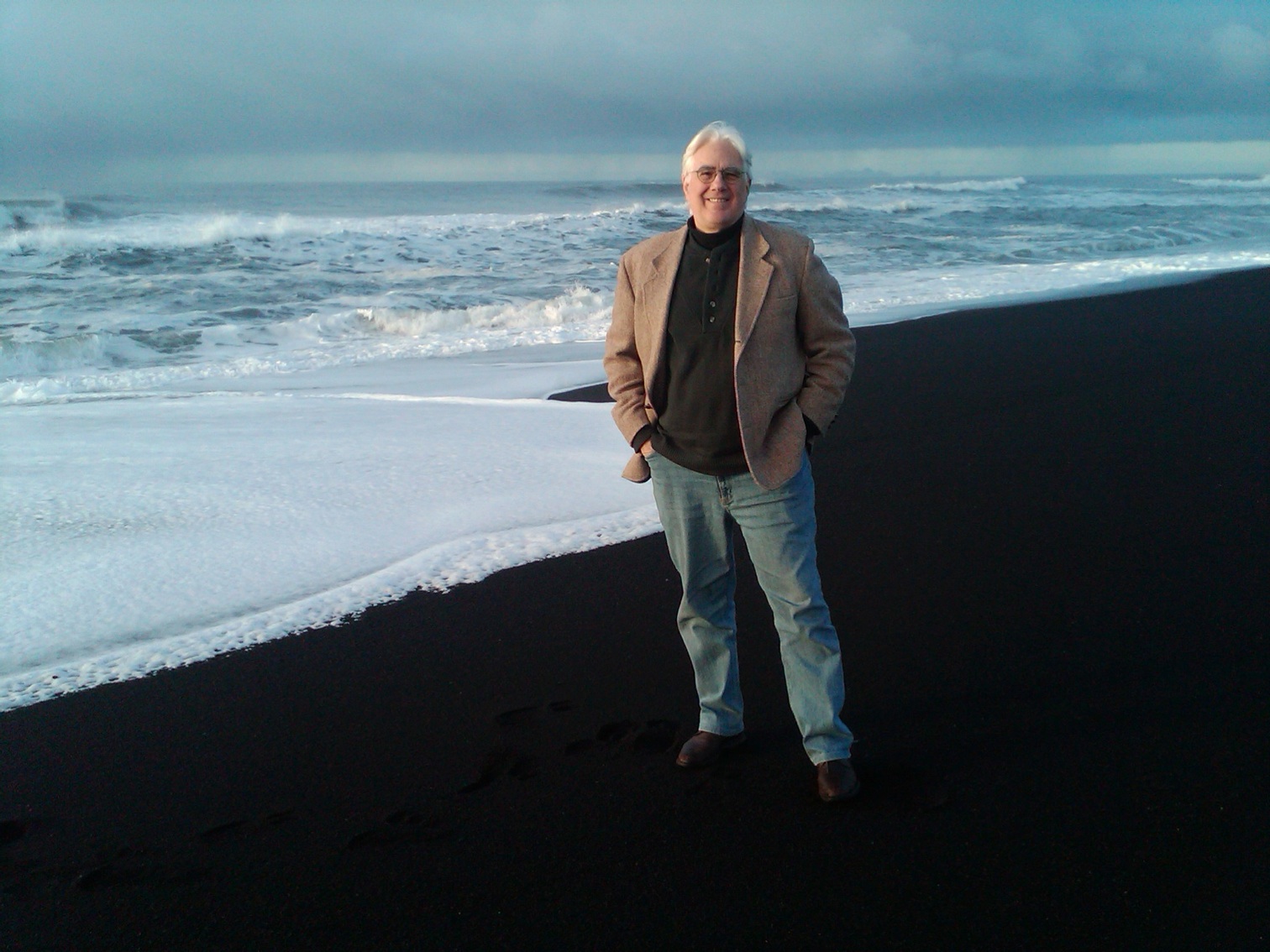 I
had climbed one of those glaciers (above)
earlier in the day, with cleats on my
feet and a spiked walking pole in my
hand, with a harness tied around me so
that, as Ingy said, “If you fall in a
crater, we can pull you out.” After
an hour, I’d had it with crunching my
feet into the sheer ice and we headed
back—over that dark, raging river.
I
had climbed one of those glaciers (above)
earlier in the day, with cleats on my
feet and a spiked walking pole in my
hand, with a harness tied around me so
that, as Ingy said, “If you fall in a
crater, we can pull you out.” After
an hour, I’d had it with crunching my
feet into the sheer ice and we headed
back—over that dark, raging river.
Nevertheless, and with no
imminent eruptions of Eyjafjallajökull
due, I would happily return to Iceland.
After tackling Covid head-on early last
spring, the country’s cases of the
disease are near zero week after week.
Good time to think about going back.
While
that may be my most vivid memory of
Iceland, all others were of astounding
beauty amidst endless desolation, which
included 250 miles of black sand beach,
which was like stepping into cold,
poured concrete. The
cloud patterns seem ferocious and
shadows move furiously over the hilly
land on which run woolly wild horses. Then
come the sunsets, whose own beauty is
but a prelude to the mystical Northern
Lights that play across a jet black sky.
Iceland has only a few towns that
rise to the name city, and the capital
of Reykjavik, founded in the 10th
century, never seems bustling. The whole
country has only 300,000 people, and
two-thirds of them live around
Reykjavik. Little traffic means little
noise, and wherever you are, you sleep
in windy silence. It is a city with few
true tourist sights, but it is as
handsome as its people, who come from
Norwegian and Celtic stock.
There are art museums, natural
history museums, a Viking Village,
opera, theater and year-round music
festivals. The Laugar Spa is rightly one
of the most popular attractions,
constantly filled with locals who come
for a work-out and then steam in a
series of shadowy, echoing rooms. The
Blue Lagoon is where, with stamina, you
can go for a cold dunk, splash around
and feel your bones shrink.
You’ll find every kind of
restaurant in the city—even Indian kebab
houses and sushi—while its native
cuisine is largely built around
reindeer, venison, lamb, and seafood,
including lusciously sweet langoustines. A
local favorite—well, actually not all
that many Icelanders crave the stuff—is
called “stinky shark,” which is
fermented by having a group of men
urinate on the dead fish, then bury it
to acquire a taste that Ingy described
as “like very strong cheese.” I passed.
But everything about
Iceland—which had so little snow
recently that the ski resort was
closed—draws you outside the towns, for
what looks virginal and primordial is
also brand new, with hillsides and
mountains, glaciers and seashore,
continually being molded by Nature,
sometimes softly, sometimes by volcanic
eruption, so that any drive or any trek
from one year to another can reveal a
new world, one that reminds you how
transient even the oldest things on
earth can be, like clouds moving over
the yawning hills and quiet little
seaside towns.
Spring and summer are ideal times
to visit Iceland, when it is green and
blooming, though I found the starkness
and play of light and dark immensely
fascinating in autumn. Winter
is not much fun, since Iceland then
labors under depressingly long, dark
days.
Reykjavik has plenty
of small hotels. One of the best is the
modern 101 Hotel (left) in
the center of town and convenient to
everything. The grandest in town is the
Hotel
Borg, with 56 rooms.
As
noted, if you’re up for Indian kebabs or
pizza, Reykjavik has it. More
traditional, and very good, is the 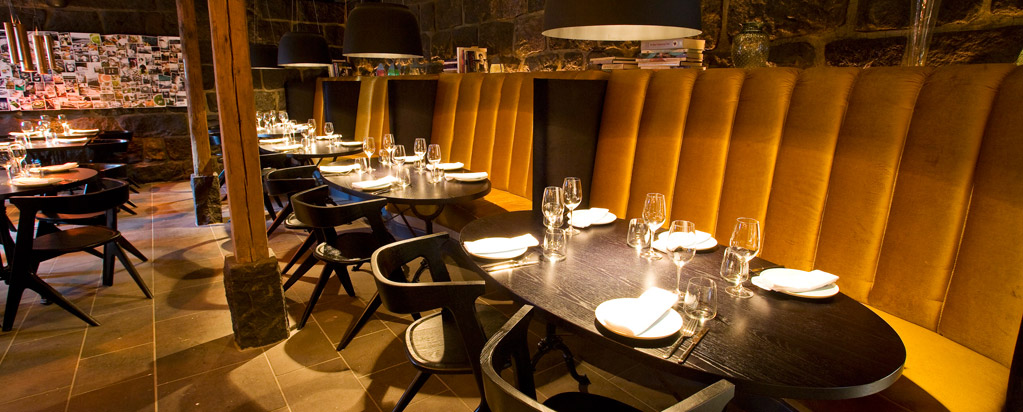 popular Fiskfélagiồ
(Fish Company; right), whose
owner and master chef,
Lárus Gunnar Jónasson does
a wide diversity of
seafood taken from local
waters. The
building dates
back to 1884, originally set elsewhere
but now on its present location
at Grófartorg. The
heritage of the building is incorporated
into “The Tides,” a work of art by
Hjörleifur Stefánsson; the
restaurant was designed by
Leif Welding with window panes
from the Hafnarfjörður Free Lutheran
Church backlit behind the bar;
signature china is from Figgijo in
Norway, and many of the items used in
the restaurant, china and kitchenware
alike, are on display and for sale in
the outer hall.There's also a wall of
food photos and on the way out
Post-Its and notes from fans who love
Fish Company's happy atmosphere and
good food.
popular Fiskfélagiồ
(Fish Company; right), whose
owner and master chef,
Lárus Gunnar Jónasson does
a wide diversity of
seafood taken from local
waters. The
building dates
back to 1884, originally set elsewhere
but now on its present location
at Grófartorg. The
heritage of the building is incorporated
into “The Tides,” a work of art by
Hjörleifur Stefánsson; the
restaurant was designed by
Leif Welding with window panes
from the Hafnarfjörður Free Lutheran
Church backlit behind the bar;
signature china is from Figgijo in
Norway, and many of the items used in
the restaurant, china and kitchenware
alike, are on display and for sale in
the outer hall.There's also a wall of
food photos and on the way out
Post-Its and notes from fans who love
Fish Company's happy atmosphere and
good food.
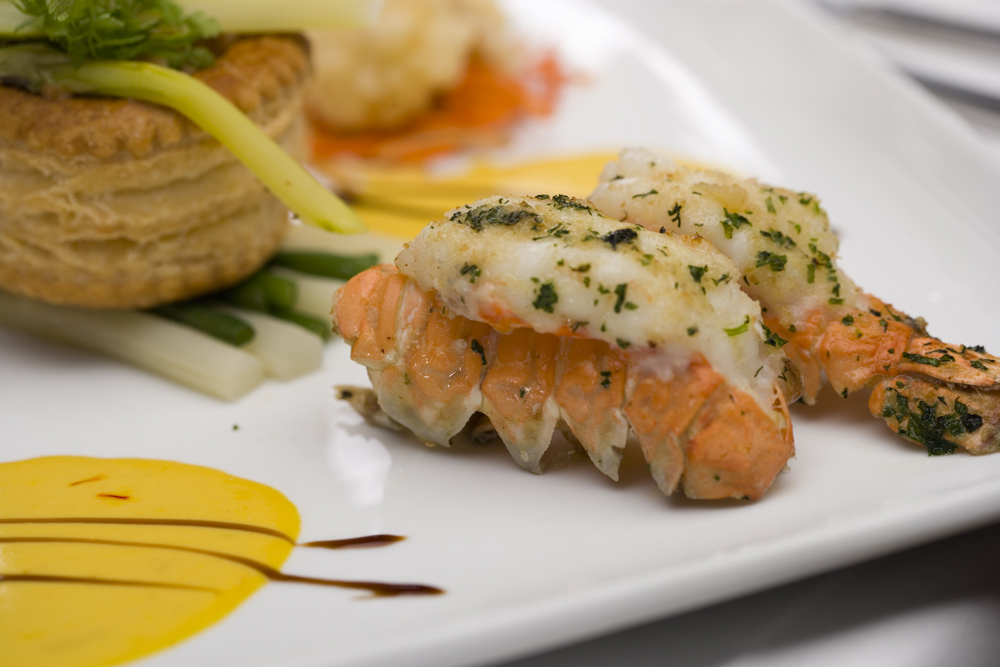 Lækjarbrekka
is a charming, multi-room restaurant
with Old Master prints and lace
curtains, and an excellent lamb dinner.
It is
s a very different kind of restaurant,
old-fashioned in the loveliest sense,
set within a house that dates to 1834 as
the house of Danish ship owner and
merchant P.C Knudtzon, who also ran a
bakery there. The baker in turn
bought the house in 1845 and prospered
as the only baker in town for years. The
building was used as a dwelling until
1961, and a small shop and then
turned into the restaurant in
1979,now a national historic landmark.
Lækjarbrekka
is a charming, multi-room restaurant
with Old Master prints and lace
curtains, and an excellent lamb dinner.
It is
s a very different kind of restaurant,
old-fashioned in the loveliest sense,
set within a house that dates to 1834 as
the house of Danish ship owner and
merchant P.C Knudtzon, who also ran a
bakery there. The baker in turn
bought the house in 1845 and prospered
as the only baker in town for years. The
building was used as a dwelling until
1961, and a small shop and then
turned into the restaurant in
1979,now a national historic landmark.
It is now very
beautiful, evocative of an older time,
done in antique furnishings and artwork,
quiet, civilized but unpretentious. I
recommend either the "Icelandic
Langoustine Feast" or the
"Icelandic Lamb Feast," both very
popular here (there is also à la carte).
The first menu features langoustine soup
with a taste of cognac and lightly
whipped cream; langoustines (left)
in three ways, grilled in garlic butter,
deep fried in tempura and pan fried with
saffron cream; and for dessert, a
three-color parfait with crunchy praline
base.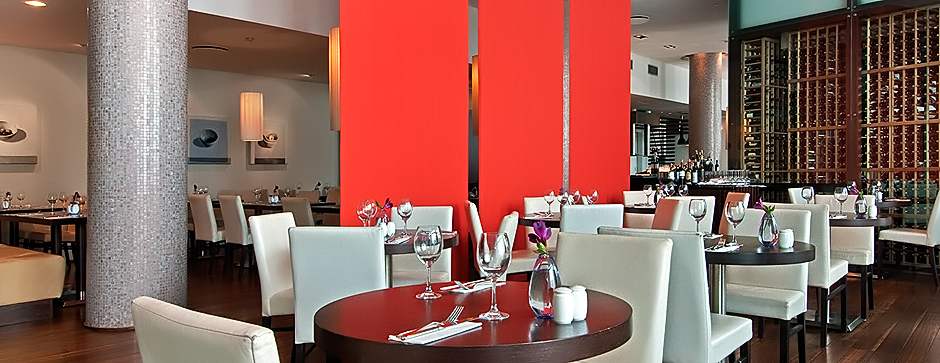
Vox
Hotel has
a Gourmet Restaurant and a more casual Bistro (right),
where I dined one afternoon. It was a buffet,
not my favorite way to eat, but it did give me a
sense of the exceptional range of the kitchen
under chef de cuisine Stefán Viðarsson,
from Nordic-style sushi and sashimi of
unstinting freshness to some well-wrought
pastas. There was asmørrebrød of
fried plaice on rye bread
with rémoulade and pickled cucumbers,
and an array of Nordic tapas, including
shrimp, smoked salmon, herring, caviar and
bread. Among the myriad desserts
offered, the one not to miss is the whipped sky,
an Icelandic cheese, with meringue,
cherries, toffee ice cream.
Currently, U.S. citizens cannot enter Iceland, but for some other nationalities the restrictions are: Passengers must show a certificate of negative PCR before boarding an aircraft to Iceland and also upon arrival. The test must be taken within 72 hours of departure.
❖❖❖
Steven
Spurrier, International Wine Legend, Dies At 79
By John
Mariani
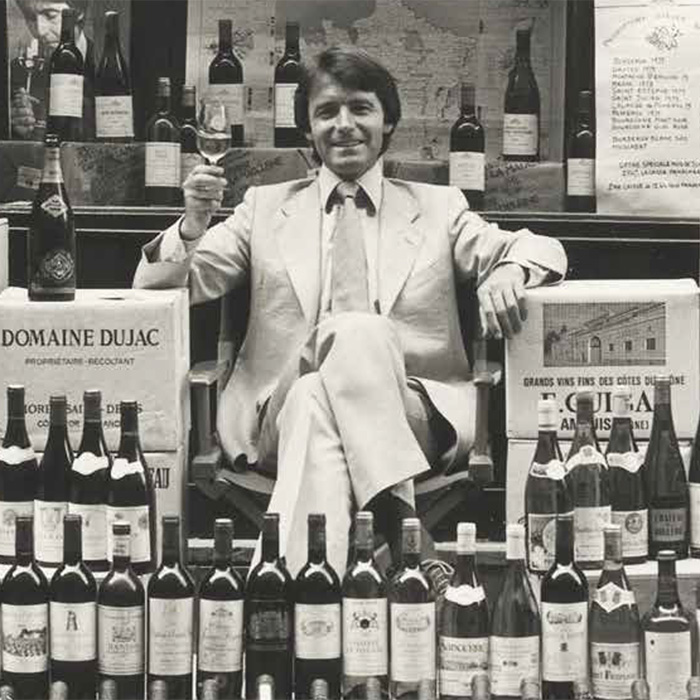 It would be difficult to come
up with any name in the international wine
market as well known as Steven Spurrier, who
died last week at the age of 79. Declared by Decanter
magazine “the great man of wine” and “Man of the
Year” for 2017, and “a pillar of opinion who
everyone respects” by the eminent wine writer
Hugh Johnson, Spurrier was best known for his
historic 1976 blind wine tasting called the
“Judgement of Paris,” at which top Bordeaux
labels were pitted against California Cabernet
Sauvignons. The results astounded connoisseurs
and flabbergasted the French when they showed
the Californians to be in the same class as the
far more illustrious Bordeaux. From that moment
on, California wines had bragging rights, and
the reaction caused even French winemakers like
Baron Philippe de Rothschild and Joseph Drouhin
to begin investing in America vineyards.
It would be difficult to come
up with any name in the international wine
market as well known as Steven Spurrier, who
died last week at the age of 79. Declared by Decanter
magazine “the great man of wine” and “Man of the
Year” for 2017, and “a pillar of opinion who
everyone respects” by the eminent wine writer
Hugh Johnson, Spurrier was best known for his
historic 1976 blind wine tasting called the
“Judgement of Paris,” at which top Bordeaux
labels were pitted against California Cabernet
Sauvignons. The results astounded connoisseurs
and flabbergasted the French when they showed
the Californians to be in the same class as the
far more illustrious Bordeaux. From that moment
on, California wines had bragging rights, and
the reaction caused even French winemakers like
Baron Philippe de Rothschild and Joseph Drouhin
to begin investing in America vineyards.
The Judgement of Paris was even the basis
for a 2008 movie called Bottle Shock, in
which Spurrier was played as an haute snob
Englishman by Alan Rickman. In real life Spurrier
couldn’t be more different: Handsome, slender,
impeccably dressed, Spurrier had an engaging
British wit and,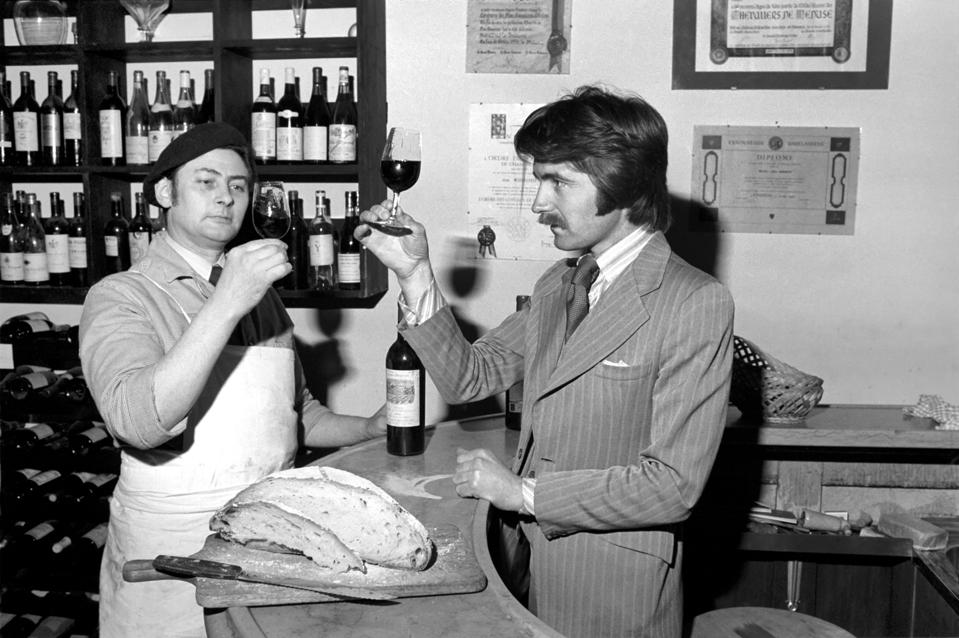 though he
took the marketing of wine seriously, he never
cared for the folderol that accompanied it.
though he
took the marketing of wine seriously, he never
cared for the folderol that accompanied it.
He began his career in 1964 at London’s
oldest wine merchant, Christopher and Company, as
a trainee, which he parlayed into a wine shop of
his own in Paris in 1971 called Les Caves de la
Madeleine–a rather gutsy thing for a Brit to
attempt in France. Furthermore, he established
France’s first wine school open to the public, L’Academie
du Vin. As a teacher he was a great raconteur and
ever patient with anyone seeking answers to the
mysteries (and follies) of wine. He became a
consultant and director of the
Christie’s Wine Course in 1988. He also co-founded
with Simon McMurtrie the Académie du Vin Library
in 2019, publishing articles and books on wines
both historic and contemporary.
 Among his
numerous awards Spurrier won Le Prix de Champagne
Lanson for wine writing, and was honored as Le
Personalité de l’Année for services to the French
wine world in 1988. He and his wife, Annabella, founded
their own winery in Bride Valley, in Dorset, with
the first vintage in 2014.
Among his
numerous awards Spurrier won Le Prix de Champagne
Lanson for wine writing, and was honored as Le
Personalité de l’Année for services to the French
wine world in 1988. He and his wife, Annabella, founded
their own winery in Bride Valley, in Dorset, with
the first vintage in 2014.
Everybody in the
wine trade and media knew Spurrier, and I met and
was fortunate to dine with him a few times over
the past four decades. I always found him a
refreshing break from the navel-gazing
connoisseurs and squinting Masters of Wine for
whom wine was more a science of forensics than a
pleasure. Like so many well-educated Brits—he, via
the Rugby School and London School of
Economics—could converse on all manner of
subjects, and his wit, while never cutting, was
always aimed squarely at pretensions. Spurrier was
the kind of jolly fellow who made wine tantalizing
and never off-putting. He was the kind of
companion who would agree with Victor Hugo when he
said, “God made only water, but man made wine.”
❖❖❖
By John Mariani
LOVE AND PIZZA
Since, for the time being, I am unable to write about or review New York City restaurants, I have decided instead to print a serialized version of my (unpublished) novel Love and Pizza, which takes place in New York and Italy and involves a young, beautiful Bronx woman named Nicola Santini from an Italian family impassioned about food. As the story goes on, Nicola, who is a student at Columbia University, struggles to maintain her roots while seeing a future that could lead her far from them—a future that involves a career and a love affair that would change her life forever. So, while New York’s restaurants remain closed, I will run a chapter of the Love and Pizza each week until the crisis is over. Afterwards I shall be offering the entire book digitally. I hope you like the idea and even more that you will love Nicola, her family and her friends. I’d love to know what you think. Contact me at loveandpizza123@gmail.com
—John Mariani
To read previous chapters go to archive (beginning with March 29, 2020, issue).
LOVE AND PIZZA
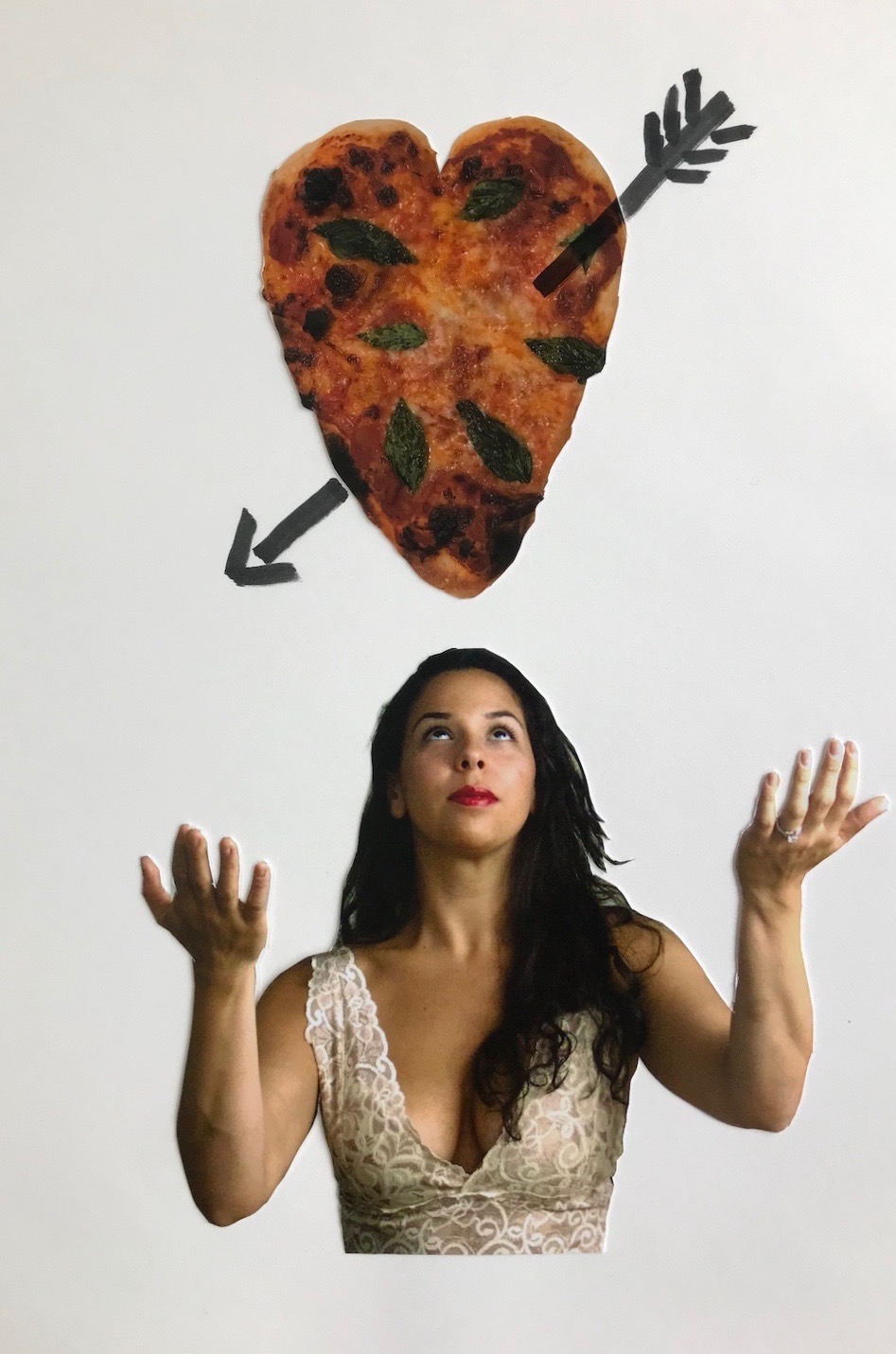
By John Mariani
Cover Art By Galina Dargery
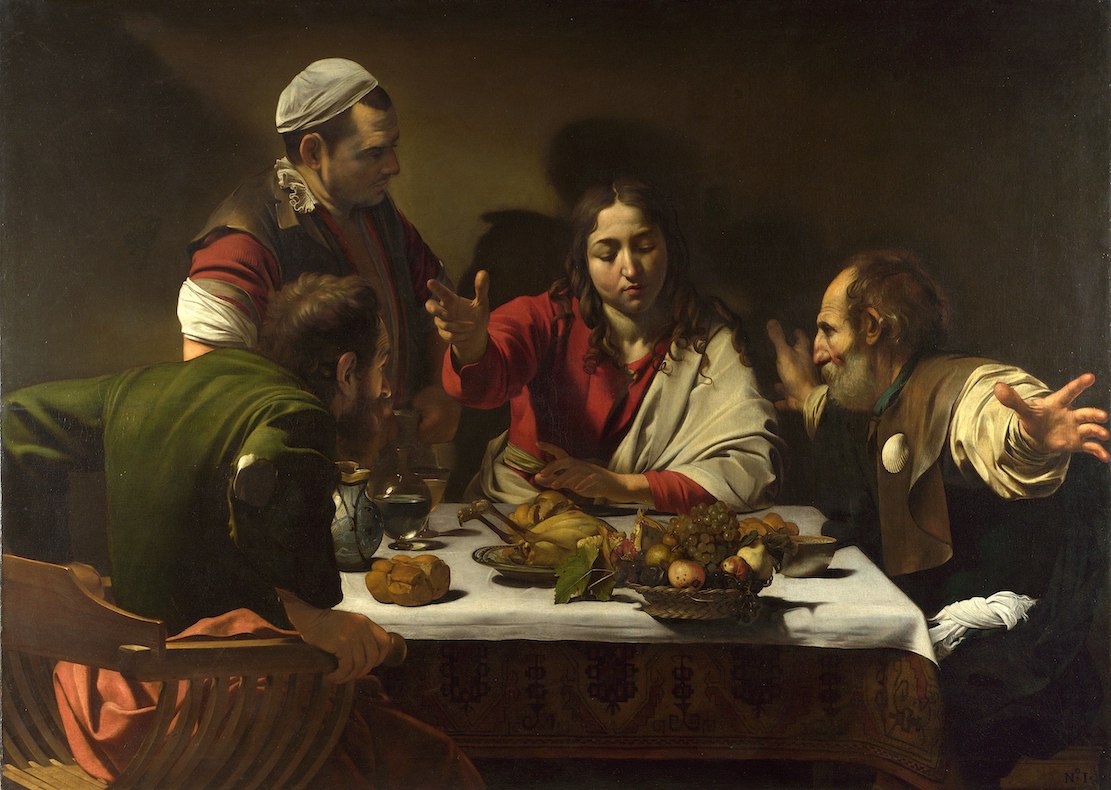
A week before the fall semester
was to begin, with time on her
hands, Nicola went to the Metropolitan
Museum of Art to see an exhibition
entitled “Temptations of the Table: Food in
Renaissance Paintings,” which
ranged from grotesque depictions of gluttony
by Hieronymus Bosch to grandiose
banquets by Veronese, and, on loan from the
National Gallery in London, the
“Supper at Emmaus,” painted by Caravaggio in
1601.
Nicola spent a good deal of time in
front of the last, recalling a later
version of the same subject that she’d seen
at the Brera in Milan and on her
visit to the Museo in
Naples and how the caravaggisti
imitated the master’s style.
The story for “Supper at
Emmaus” came from the Gospel of Luke,
wherein Christ, just risen from the
tomb, meets two of his disciples on
the road to the town of Emmaus, but
they do not recognize Him. While
breaking bread, He reveals Himself,
then miraculously vanishes.
Nicola looked first at the
composition, a tight dark rectangle,
with the two disciples and a man from
the inn framing a beardless Christ in
brilliant red and white robes. One
disciple’s hands make a sharp diagonal
that ends at Christ’s left shoulder as
Christ gestures outward, almost
three-dimensionally, while the other
disciple’s elbow extends further out
to the edge of the painting.
There is a hushed serenity to
the scene, and the food on the table
is a kind of still life rare in
Renaissance art—loaves of bread, a
roasted fowl, beakers of wine and
water.
A fruit basket teeters on the
edge of the table, perhaps dislodged
by the surprised disciple, which
creates the tension in the room.
“Look at the seashell on the
disciple on the right,” said a voice
from behind Nicola. “That is St.
Peter, a lowly fisherman.”
Nicola recognized the voice
immediately and turned around slowly.
“Marco!” she said, surprised but
trying not to imply anything more.
“Hello, Nicola. It’s good to
see you.”
“Well, uh, what a coincidence.”
“Not so much. I
saw you walking on Fifth Avenue from
my apartment window,” he said, nodding
his head backwards towards his
building. “So
I came over and knew I’d find you
standing right here.”
Nicola said nothing, so Marco
spoke.
“It is such a beautiful
painting, isn’t it? It
is realism but baroque at the same
time.
The figures are all simple
people.
They can’t believe they are
seeing Jesus come back from the dead.
And look at the way Caravaggio
ennobles the humble meal they are
having, which echoes the one they had
at the Last Supper. ”
Nicola joined in. “Yes, and
look how the innkeeper adds a little
note of wit—he doesn’t have a clue
what’s going on.”
“Nicola, do you remember when
we were in the Museo
in Naples and we talked about the way
the caravaggisti couldn’t help
themselves from taking what they saw
in Caravaggio and then made everything
more theatrical. You
look at this painting and you see what
I meant about us Neapolitans. We
sometimes become overexcited and
forget what’s real.”
Nicola sensed Marco was
describing himself, maybe Nicola too.
“Well,
as someone who’s one-half Neapolitan,
I know exactly what you mean. So,
Marco, how have you been?”
Marco shook his head, rubbed
what looked like a three days’ growth
of beard, and said, “To tell you the
truth, Nicola, I have not been well.”
A chill ran through Nicola.
“What's the matter?”
“Oh, don't worry, I am not
sick.
Except maybe here”—he pointed
to his forehead—“and here,” tapping
his heart.
“I
realized how stupid I was when we last
met.
Maybe I should not have said
anything, but I thought the truth
would hurt you just enough. Instead
I hurt you very, very much. And
since then, well, my heart has been
empty, numb, without feeling, as if it
did not beat any more.”
Nicola remained silent,
clutching the strap of her handbag
with both hands.
“I know now that losing you was
losing everything I was in New York
for,” he continued. “When
I think about it, I believe I accepted
this stupid job just to come to New
York and see the beautiful Nicola
Santini.”
Nicola knew she had to say
something, so she asked, “How’s the
job going?”
“I’m quitting. I
couldn’t stand doing what they asked
me to do. I came to hate that child I
call `chicken fingers,’ and I found
that, without you around, I had much
too much time to think.”
“What about your painting?”
“I have not picked up a brush
in weeks,” said Marco. “I have not the
inspiration. Let
me tell you something, Nicola, when we
were together, I wanted you to be my
model, my muse. You,
with your love of art and food, it was
perfect—even aside from my falling in
love with you. So,
when I saw that your career was going
faster and faster and was keeping us
apart, I went crazy. And I shall never
forgive myself for what happened.”
Then, trying to lighten the
moment, he asked, “But, Nicola, tell
me about your life and what you are
doing.
I read about you, you know, in
the newspaper. You
signed a big contract with a fashion
company?”
“Well, it’s a cosmetics company
and, yes, the contract is pretty big.”
“Congratulations, Nicolina,” he
said, using the diminutive for the
first time. “You work hard, you
deserve your success. But are you
still going to graduate school?”
Nicola’s heart was racing.
“Oh, absolutely, Marco! This
contract actually prohibits me from
working for anyone else but
Vivace—that’s the company’s name—so I
will have plenty of time for my
studies. It’s really worked out as
perfectly as I could want.”
Marco nodded, looking sad.
“That’s wonderful. I
am so happy for you. Too bad you
didn't sign that contract last spring. Maybe
we would have had more time together
then.”
Nicola changed the subject and
asked, “So, if you quit the job here,
what will you do, cook in a restaurant
or go back to Italy.”
Marco threw up his hands and
said, “I could get a job in New
York—I’m still on a tourist visa—but
you know how I feel about the Italian
food here. Unless
I could cook my own food, exactly the
way I wanted, I would probably walk
out of the kitchen after two days. So,
I will probably go back to Naples, try
to start painting again and cook the
way I want at Benedetto when the new
season begins. By the way, how is your
brother’s place doing?”
Something lit up in Nicola.
“Uh, Tony’s doing fine, the business
is good . . .”
“But the food is not so good
still?”
Nicola bit her lip and said,
“Marco, what if you came to work for
Tony at Alla Teresa?”
Marco look very surprised,
suddenly having another option on his
plate and realizing that perhaps
Nicola had softened in her attitude
towards him.
“Work at Alla Teresa?” he said,
rubbing his chin. “But I would be
cooking Tony’s food, right?”
“Oh, for chrissakes, Marco, no!
If you came to work for Tony—you know
he thinks you're the best chef he’s
ever met—if you worked for him, the
kitchen would be all yours.”
“Excuse me, Nicola, but what
would I be paid?”
“I know he’s paying the current
chef $40,000. I’m sure he’d pay you
more.”
Marco’s eyebrows lifted. “That
would be very generous. How many days
would I work?”
Nicola said, “Well, the
restaurant’s closed on Mondays, so,
oh, damnit, Marco, take the job,
please take the job!”
Marco hated to see Nicola
frown. “Nicolina, I will take the job
. . .
on
one condition.”
“What, Marco?”
“That you forgive me for
everything. It’s the only way I could
work there and see you come in every
day.
I couldn’t bear thinking you
still hated me.”
Nicola put her arms around
Marco and said, “Oh, Marco, I never
hated you. I
felt betrayed. I was betrayed. But
I was being selfish. And
in all the time since then, I hoped I
would meet you again someday and that
we could patch everything up.”
Marco hugged her very firmly
and said, “Oh, Nicolina, I have missed
you so much.”
Though they both wanted very
much to indulge their wildest, loudest
Neapolitan brio right there in the
middle of the gallery, as much out of
respect for the museum as for the
visitors, they merely kissed each
other long and silently. Then Nicola
said, “ I hope you still have your
apartment across the street.”
Marco grabbed her hand and they
started out of the gallery.
Nicola
blew a little kiss to the Christ
figure in the painting.
“Why did you do that?” asked
Marco.
“I said a little prayer the
moment I heard your voice.”
Sponsored by

Any of John Mariani's books below may be ordered from amazon.com.
 The Hound in Heaven
(21st Century Lion Books) is a novella, and
for anyone who loves dogs, Christmas, romance,
inspiration, even the supernatural, I hope you'll find
this to be a treasured favorite. The story
concerns how, after a New England teacher, his wife and
their two daughters adopt a stray puppy found in their
barn in northern Maine, their lives seem full of promise.
But when tragedy strikes, their wonderful dog Lazarus and
the spirit of Christmas are the only things that may bring
his master back from the edge of despair.
The Hound in Heaven
(21st Century Lion Books) is a novella, and
for anyone who loves dogs, Christmas, romance,
inspiration, even the supernatural, I hope you'll find
this to be a treasured favorite. The story
concerns how, after a New England teacher, his wife and
their two daughters adopt a stray puppy found in their
barn in northern Maine, their lives seem full of promise.
But when tragedy strikes, their wonderful dog Lazarus and
the spirit of Christmas are the only things that may bring
his master back from the edge of despair. WATCH THE VIDEO!
“What a huge surprise turn this story took! I was completely stunned! I truly enjoyed this book and its message.” – Actress Ali MacGraw
“He had me at Page One. The amount of heart, human insight, soul searching, and deft literary strength that John Mariani pours into this airtight novella is vertigo-inducing. Perhaps ‘wow’ would be the best comment.” – James Dalessandro, author of Bohemian Heart and 1906.
“John Mariani’s Hound in Heaven starts with a well-painted portrayal of an American family, along with the requisite dog. A surprise event flips the action of the novel and captures us for a voyage leading to a hopeful and heart-warming message. A page turning, one sitting read, it’s the perfect antidote for the winter and promotion of holiday celebration.” – Ann Pearlman, author of The Christmas Cookie Club and A Gift for my Sister.
“John Mariani’s concise, achingly beautiful novella pulls a literary rabbit out of a hat – a mash-up of the cosmic and the intimate, the tragic and the heart-warming – a Christmas tale for all ages, and all faiths. Read it to your children, read it to yourself… but read it. Early and often. Highly recommended.” – Jay Bonansinga, New York Times bestselling author of Pinkerton’s War, The Sinking of The Eastland, and The Walking Dead: The Road To Woodbury.
“Amazing things happen when you open your heart to an animal. The Hound in Heaven delivers a powerful story of healing that is forged in the spiritual relationship between a man and his best friend. The book brings a message of hope that can enrich our images of family, love, and loss.” – Dr. Barbara Royal, author of The Royal Treatment.
 |
The Encyclopedia of American Food and Drink by John F. Mariani (Bloomsbury USA, $35) Modesty forbids me to praise my own new book, but let me proudly say that it is an extensive revision of the 4th edition that appeared more than a decade ago, before locavores, molecular cuisine, modernist cuisine, the Food Network and so much more, now included. Word origins have been completely updated, as have per capita consumption and production stats. Most important, for the first time since publication in the 1980s, the book includes more than 100 biographies of Americans who have changed the way we cook, eat and drink -- from Fannie Farmer and Julia Child to Robert Mondavi and Thomas Keller. "This book is amazing! It has entries for everything from `abalone' to `zwieback,' plus more than 500 recipes for classic American dishes and drinks."--Devra First, The Boston Globe. "Much needed in any kitchen library."--Bon Appetit. |
"Eating Italian will never be the same after reading John Mariani's entertaining and savory gastronomical history of the cuisine of Italy and how it won over appetites worldwide. . . . This book is such a tasteful narrative that it will literally make you hungry for Italian food and arouse your appetite for gastronomical history."--Don Oldenburg, USA Today. "Italian
restaurants--some good, some glitzy--far
outnumber their French rivals. Many of
these establishments are zestfully described
in How Italian Food Conquered the World, an
entertaining and fact-filled chronicle by
food-and-wine correspondent John F.
Mariani."--Aram Bakshian Jr., Wall Street
Journal.
"Equal parts
history, sociology, gastronomy, and just
plain fun, How Italian Food Conquered the
World tells the captivating and delicious
story of the (let's face it) everybody's
favorite cuisine with clarity, verve and
more than one surprise."--Colman Andrews,
editorial director of The Daily
Meal.com. "A fantastic and fascinating
read, covering everything from the influence
of Venice's spice trade to the impact of
Italian immigrants in America and the
evolution of alta cucina. This book will
serve as a terrific resource to anyone
interested in the real story of Italian
food."--Mary Ann Esposito, host of PBS-TV's
Ciao
Italia. "John Mariani has written the
definitive history of how Italians won their
way into our hearts, minds, and
stomachs. It's a story of pleasure over
pomp and taste over technique."--Danny Meyer,
owner of NYC restaurants Union Square
Cafe, The Modern, and Maialino.
|
 |
 |
 |
 |
 |
 |
 |
 |
 Everett Potter's Travel Report:
Everett Potter's Travel Report: 
 Eating Las
Vegas JOHN CURTAS has been covering
the Las Vegas food and restaurant scene
since 1995. He is the co-author of EATING LAS
VEGAS – The 50 Essential Restaurants (as
well as the author of the Eating Las
Vegas web site: www.eatinglasvegas.
He can also be seen every Friday morning as
the “resident foodie” for Wake Up With the
Wagners on KSNV TV (NBC) Channel 3 in
Las Vegas.
Eating Las
Vegas JOHN CURTAS has been covering
the Las Vegas food and restaurant scene
since 1995. He is the co-author of EATING LAS
VEGAS – The 50 Essential Restaurants (as
well as the author of the Eating Las
Vegas web site: www.eatinglasvegas.
He can also be seen every Friday morning as
the “resident foodie” for Wake Up With the
Wagners on KSNV TV (NBC) Channel 3 in
Las Vegas.
MARIANI'S VIRTUAL GOURMET
NEWSLETTER is published weekly. Publisher: John Mariani. Editor: Walter Bagley. Contributing Writers: Christopher Mariani,
Robert Mariani, Misha Mariani, John A. Curtas, Gerry Dawes, Geoff Kalish,
and Brian Freedman. Contributing
Photographer: Galina Dargery. Technical
Advisor: Gerry
McLoughlin.
If you wish to subscribe to this
newsletter, please click here: http://www.johnmariani.com/subscribe/index.html
© copyright John Mariani 2021

